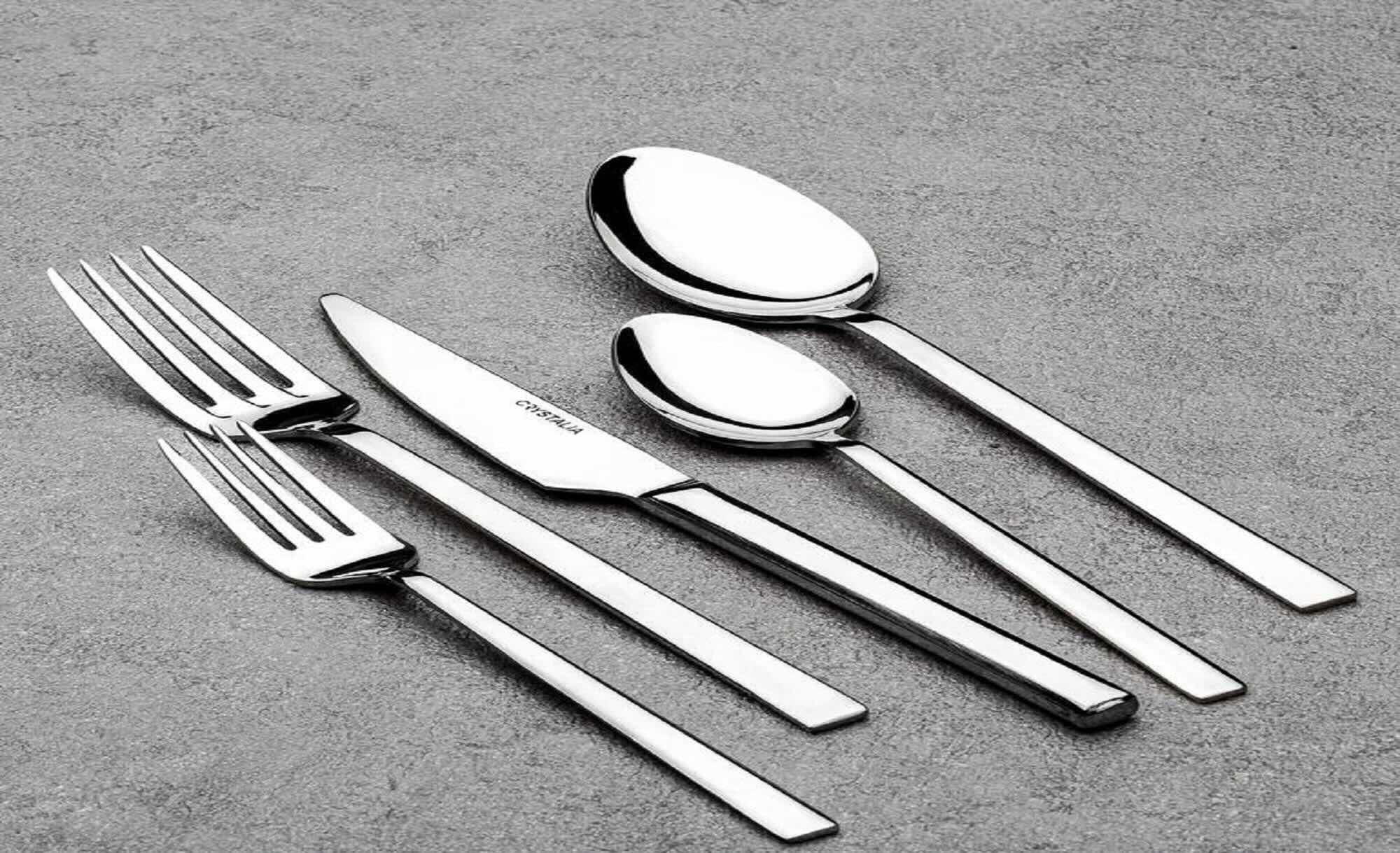

Tableware
What Does 18/10 Mean On Silverware
Modified: December 7, 2023
Discover the meaning of 18/10 on silverware and its significance in tableware. Uncover the quality and composition behind this popular term.
(Many of the links in this article redirect to a specific reviewed product. Your purchase of these products through affiliate links helps to generate commission for Storables.com, at no extra cost. Learn more)
Introduction
Tableware is an essential part of any dining experience, and investing in high-quality silverware can elevate your meals to a whole new level. When shopping for silverware, you may come across a term called “18/10.” But what does it mean? In this article, we’ll explore the meaning of “18/10” in the context of silverware and its significance in determining the quality of the utensils you use.
Understanding the composition of silverware is crucial in making an informed purchasing decision. The ratio mentioned, such as 18/10, refers to the percentage of specific metals in the silverware. This ratio indicates the percentage of chromium and nickel present in the stainless steel used to manufacture the utensils.
Now, let’s delve deeper into what exactly “18/10” means and how it impacts the performance and durability of your silverware.
Key Takeaways:
- The “18/10” ratio in silverware indicates the percentage of chromium and nickel in the stainless steel, offering superior durability, resistance to corrosion, and a luxurious luster, making it the gold standard for high-quality utensils.
- Investing in 18/10 silverware ensures a sophisticated dining experience with its easy maintenance, resistance to scratches, and elegant design, making it a worthwhile choice for those who value quality and style in their tableware.
Read more: What Does 100 Stamped On Silverware Mean
Understanding Silverware Ratios
When it comes to silverware, the ratio mentioned refers to the composition of the stainless steel used in the manufacturing process. Stainless steel is an alloy that combines various metals to create a durable and corrosion-resistant material. Two key metals used in silverware are chromium and nickel.
The ratio represents the percentage of chromium and nickel present in the stainless steel. For example, the ratio “18/10” indicates that the stainless steel used contains 18% chromium and 10% nickel. This composition is often considered the gold standard in high-quality silverware.
Chromium is added to stainless steel to provide it with its corrosion-resistant properties. It forms a protective layer on the surface that prevents rust and staining. Meanwhile, nickel enhances the durability and shine of the silverware. It adds a lustrous finish and improves the utensils’ resistance to scratches and wear.
Understanding these ratios is essential because they determine the quality and performance of your silverware. Different ratio combinations will result in variations in durability, shine, and resistance to corrosion. By examining the ratio, you can determine the level of quality and longevity you can expect from your silverware.
What Does “18/10” Mean?
In the world of silverware, “18/10” is a term used to indicate the ratio of chromium to nickel in the stainless steel used to make the utensils. Specifically, it means that the stainless steel consists of 18% chromium and 10% nickel. This ratio is often considered the highest quality and is commonly used in premium and professional-grade silverware sets.
The 18/10 ratio is highly desirable due to its superior durability and shine. The chromium content provides excellent corrosion resistance, ensuring that your silverware remains tarnish-free and withstands the rigors of daily use. Nickel, on the other hand, enhances the luster and aesthetic appeal of the utensils while adding strength and resistance to scratches.
When you opt for 18/10 silverware, you can expect a brilliant, mirror-like finish that adds an elegant touch to your table setting. The pieces will have a substantial weight and feel sturdy in your hands, indicating their high-quality construction. Additionally, the 18/10 silverware sets often feature intricate designs and attention to detail, making them a popular choice for formal dining occasions.
It’s important to note that some manufacturers may label their silverware as “18/0,” indicating that it contains 18% chromium and no nickel. While this ratio is still considered stainless steel, it may not possess the same level of durability and resistance to corrosion as 18/10 silverware. The absence of nickel can result in a less lustrous finish and make the utensils more prone to scratches.
Overall, the “18/10” ratio is synonymous with high-quality silverware that offers durability, shine, and elegance. When you invest in 18/10 silverware, you can expect your utensils to withstand the test of time and elevate your dining experience to a new level of sophistication.
The Role of Nickel in Silverware
When it comes to silverware, the presence of nickel in the stainless steel composition plays a critical role in determining its quality and performance. Nickel is added to stainless steel for several reasons, including its impact on durability, shine, and resistance to corrosion.
One of the main benefits of nickel in silverware is its contribution to the overall strength and durability of the utensils. Nickel helps to enhance the tensile strength of the stainless steel, making it more resistant to bending and breaking. This means that silverware with a higher nickel content is less likely to deform or snap during regular use.
Nickel also plays a significant role in creating the shine and luster that is characteristic of high-quality silverware. It provides a bright and reflective surface, giving the utensils their attractive appearance. This lustrous finish not only adds an aesthetic element to your table setting but also makes your silverware stand out among other utensils.
Furthermore, the presence of nickel enhances the resistance of silverware to scratches and wear. The nickel content forms a protective layer on the stainless steel’s surface, making it more resilient to the daily wear and tear that silverware typically undergoes. As a result, silverware with a higher nickel ratio is less likely to develop scratches or lose its shine over time.
In addition to its durability and aesthetics, nickel also contributes to the corrosion resistance of silverware. The stainless steel alloy enriched with nickel forms a passive layer that acts as a barrier against oxidation and rust formation. This means that silverware with a higher nickel content, such as 18/10, is more resistant to tarnish, stains, and corrosion, ensuring that your utensils retain their pristine appearance for longer.
Overall, the inclusion of nickel in silverware is vital for achieving superior durability, shine, and resistance to corrosion. It not only adds strength to the utensils but also enhances their aesthetic appeal, making nickel-containing silverware a reliable and visually appealing choice for your table setting.
When you see “18/10” on silverware, it refers to the composition of the metal. It means that the silverware is made of 18% chromium and 10% nickel, indicating a high-quality and durable product.
The Benefits of 18/10 Silverware
Opting for 18/10 silverware offers several advantages that make it a top choice for discerning individuals and professional chefs alike. This ratio, which refers to the chromium to nickel composition in the stainless steel, ensures exceptional quality and performance in your utensils. Here are some of the benefits of choosing 18/10 silverware:
1. Durability: With 18% chromium and 10% nickel, 18/10 silverware is highly resistant to corrosion and tarnish. This means that your utensils will remain in excellent condition, even with regular use and exposure to moisture. The stainless steel construction makes them sturdy and less prone to bending or breaking, ensuring their longevity.
2. Shine and Luster: Nickel, present in the 18/10 ratio, contributes to the high shine and mirror-like finish of the silverware. This lustrous appearance adds a touch of elegance to your table setting and showcases your attention to detail. The brilliance of 18/10 silverware reflects light beautifully, enhancing the aesthetics of your dining experience.
3. Resistance to Scratches: The inclusion of nickel in 18/10 silverware enhances its resistance to scratches and wear. This means that your utensils will retain their smooth surfaces and attractive finish, even with regular handling and use. The nickel content forms a protective layer, reducing the likelihood of visible marks or signs of wear over time.
4. Versatility: 18/10 silverware is suitable for various dining occasions, from everyday meals to formal gatherings. The superior quality and eye-catching design of this silverware make it an excellent choice for elevating any table setting. Whether you’re hosting a dinner party or enjoying a quiet meal at home, 18/10 silverware adds a touch of sophistication to your dining experience.
5. Easy Maintenance: Cleaning and maintaining 18/10 silverware is a breeze. The corrosion-resistant properties of the stainless steel make it less prone to staining, requiring minimal effort to keep the utensils in pristine condition. Simply hand wash them with mild soap and water or use a dishwasher, and they will retain their shine and beauty for years to come.
Investing in 18/10 silverware ensures that you have utensils that not only deliver on aesthetics but also stand the test of time. The durability, shine, and resistance to scratches make 18/10 silverware a worthwhile investment for anyone who values quality and style in their tableware.
Read more: What Does “IS” On Silverware Stand For
Different Silverware Ratios Explained
When shopping for silverware, you may come across various ratio combinations that indicate the composition of the stainless steel used in the utensils. Each ratio carries its own characteristics and affects the performance and quality of the silverware. Here, we’ll explore some of the most commonly used silverware ratios:
1. 18/0: This ratio means that the stainless steel contains 18% chromium and no nickel. While 18/0 silverware is still considered stainless steel, it may be less durable and prone to staining compared to ratios that include nickel. It is often more affordable but may require more maintenance to keep it looking its best.
2. 18/8: With 18% chromium and 8% nickel, this ratio offers a balance between durability and affordability. It provides good resistance to corrosion and a pleasant shine, making it a popular choice for everyday silverware.
3. 18/10: The 18/10 ratio is considered the gold standard for high-quality silverware. It consists of 18% chromium and 10% nickel, delivering excellent durability, resistance to corrosion, and a luxurious luster. 18/10 silverware is often found in fine dining establishments and is a sought-after choice for those who value premium quality.
4. 13/0: This ratio contains 13% chromium and no nickel. It is often used for highly cost-effective silverware options. While it may lack the same durability and shine as higher nickel-containing ratios, it can still provide a budget-friendly alternative for casual dining.
5. 10/0: 10/0 indicates that the stainless steel contains 10% chromium and no nickel. Similar to 13/0, this ratio is commonly used in more affordable silverware sets. However, it may be more susceptible to corrosion and staining compared to higher nickel ratios.
When choosing the right silverware ratio, consider your specific needs and preferences. If durability, resistance to corrosion, and a luxurious appearance are important to you, opting for 18/10 silverware is recommended. However, if you’re on a budget or require silverware for casual use, ratios like 18/0 or 13/0 can still provide functional options.
Ultimately, the ratio you choose will determine the performance, durability, and aesthetic appeal of your silverware. Understanding the significance of these ratios will help you make an informed decision when selecting the perfect set of utensils for your dining needs.
Care and Maintenance of 18/10 Silverware
Proper care and maintenance are essential to keep your 18/10 silverware looking its best and prolong its lifespan. While 18/10 silverware is durable and resistant to corrosion, following these care tips will ensure that your utensils retain their shine and pristine condition:
1. Handwashing: Whenever possible, handwashing is recommended for 18/10 silverware. Use warm water, mild dish soap, and a soft sponge or cloth to gently clean the utensils. Avoid using abrasive sponges or harsh cleaning agents, as they can dull the finish or scratch the surface.
2. Proper Drying: After washing, thoroughly dry your silverware to prevent water spots or mineral buildup. Use a clean, soft cloth to towel dry each piece, ensuring that no moisture remains on the surface before storing them.
3. Avoid Harsh Chemicals: Keep your 18/10 silverware away from harsh chemicals such as bleach or chlorine, as they can damage the stainless steel and diminish its shine. Also, avoid using silver polish or harsh abrasives as they can scratch the surface and remove the protective layer.
4. Storing Properly: Store your silverware in a dry and clean environment. Avoid stacking the utensils tightly, as this can cause scratches and damage. Consider using individual sleeves or a tarnish-resistant cloth to separate each piece and minimize contact between them.
5. Regular Maintenance: Periodically inspect your 18/10 silverware for any signs of damage or corrosion. If you notice any discoloration or stubborn stains, you can use a stainless steel cleaner or a paste made of baking soda and water to gently remove them. Always remember to rinse and dry the utensils thoroughly after cleaning.
6. Avoid Extreme Temperatures: Avoid subjecting your silverware to extreme temperature changes, such as transferring directly from a hot dishwasher to a cold surface. Sudden temperature changes can cause the silverware to warp or lose its shine.
With proper care and maintenance, your 18/10 silverware will continue to impress with its durability and timeless beauty. By following these guidelines, you can ensure that each meal is accompanied by gleaming utensils that enhance your dining experience.
Conclusion
Selecting the right silverware is essential for creating an enjoyable dining experience. Understanding the ratios and composition of the stainless steel used in silverware can help you make informed choices. The “18/10” ratio, indicating 18% chromium and 10% nickel, is considered the gold standard for high-quality silverware.
Investing in 18/10 silverware offers numerous benefits. The combination of chromium and nickel provides superior durability, resistance to corrosion, and a luxurious luster. These utensils not only withstand the rigors of daily use but also add an elegant touch to your table setting.
While 18/10 silverware requires proper care and maintenance, it is relatively easy to keep it looking its best. Handwashing, proper drying, and avoiding harsh chemicals are key to preserving its shine and preventing scratches. Storing the silverware properly and regularly inspecting for damage will ensure its longevity and pristine appearance.
When shopping for silverware, you may come across different ratios, such as 18/0 or 18/8, each offering its own characteristics and price points. It is important to consider your needs and budget when making a selection. However, if you seek exceptional quality and long-lasting beauty, 18/10 silverware is the preferred choice.
By understanding the significance of silverware ratios and taking care of your 18/10 silverware, you can enhance your dining experience and create lasting memories. Whether it’s a casual family meal or an elegant dinner party, the durability, shine, and elegance of 18/10 silverware will elevate any table setting.
So, go ahead and invest in 18/10 silverware to enjoy the benefits of superior quality, timeless aesthetics, and the joy of dining with utensils that are both functional and beautiful.
Frequently Asked Questions about What Does 18/10 Mean On Silverware
Was this page helpful?
At Storables.com, we guarantee accurate and reliable information. Our content, validated by Expert Board Contributors, is crafted following stringent Editorial Policies. We're committed to providing you with well-researched, expert-backed insights for all your informational needs.















0 thoughts on “What Does 18/10 Mean On Silverware”